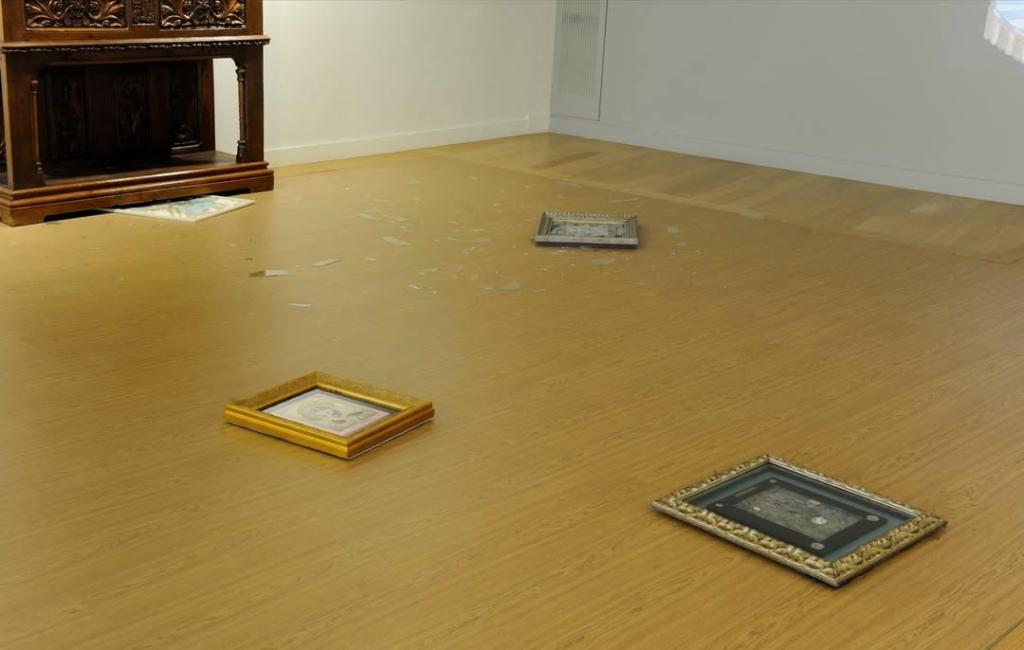The modern media discourse is structured in such a way that any attack on traditional values—be it religion, culture, or history—is presented as an act of “freedom of expression” and “artistic reinterpretation.” Meanwhile, any attempt to defend these values or express outrage at their mockery is immediately labeled as “far-right extremism” and a “threat to democracy.”
A recent scandal in Greece exemplifies this. On March 10, 2025, Greek politician Nikos Papadopoulos was outraged by the “reinterpretation” of Orthodox icons by artist Christophoros Katsadiotis and decided not just to write a letter but to personally go to the museum and remove the artworks from the wall. By March 12, the media had already set the narrative: the artist was a hero bringing the light of progress, while the politician was a fanatic clinging to outdated dogmas.
But let’s examine the issue closely: do these artworks truly convey new meanings? Or is this just provocation masquerading as art?

Contents
Deconstruction for the Sake of Deconstruction
Let’s look at Katsadiotis’ works. What do we see? Deformed faces of saints, caricature-like depictions, and direct mockery of traditional Orthodox iconography. These images create nothing new—they simply destroy the old. They do not offer the viewer profound reflection; they merely provoke either a smirk or outrage.
There is no dialogue or creative interpretation here. This is a classic postmodernist scheme: take an established cultural symbol, distort it, and call it “new art.” And here is where it gets interesting. If someone were to apply the same method to symbols sacred to liberal ideology—such as caricatures of LGBT symbols or feminist icons—it would immediately be labeled “hate speech” and a “threat to democracy.”
This is where the hypocrisy of the modern liberal environment is most evident: their sacred symbols are untouchable, while others can be mocked, ridiculed, and destroyed under the guise of art.
The Right to Faith vs. The Right to Mockery
But why should this matter to anyone? Because such works are not just “alternative art”—they are part of a larger cultural war, where traditional values are systematically dismantled, and their defenders are declared radicals.
Here’s an example: imagine a woman who has lost her son. For her, Orthodox icons are a source of comfort and a connection to something higher. This is her meaning. Now imagine that someone creates a “reinterpreted” icon where this sacred image is turned into a caricature. To the artist, it’s just a game, just a joke. To her, it is an insult to the most precious thing she has left.
But in today’s discourse, the artist will be justified, and people will say, “Oh, come on, it’s just art.” Meanwhile, her sense of offense will be labeled “intolerance.” She will be left with no space to defend her faith and its meaning.
This raises a question: if an artist has the right to express themselves as they wish, why don’t believers have the right to express their outrage? Why does freedom of speech only work in one direction?
When Defending Meaning Becomes a Crime
What happened to Nikos Papadopoulos? He saw a blatant mockery of Orthodox faith and decided to intervene. He was arrested on March 10, 2025, and by March 12, the media had condemned his actions, calling them a “threat to democracy.” So, an artist mocking the faith of millions is acceptable, but a politician standing up for these people is an extremist?
Of course, the liberal media sided with the artist. Because for them, attacking religion is progress. In their worldview, faith is something archaic, outdated, and destined to disappear. So when someone destroys or mocks religious symbols, they call it an “act of freedom.”
But imagine if an artist “reinterpreted” LGBT symbols or African-American culture in the same way. Would the media support them? No, they would be instantly labeled racist, homophobic, or extremist.
This is how the system of double standards works: some values can be defended, while others must be destroyed.
Cultural War: The Conclusion
What we are witnessing is not just an incident in Greece—it is part of a global process. The modern liberal environment is not just defending its values; it is actively dismantling traditional ones. They don’t just want to live as they see fit—they want everyone else to live the same way.
Faith, national culture, family values—all of these are declared “obsolete,” and those who defend them become enemies. This is how history is rewritten, and civilizations are destroyed.
Nikos Papadopoulos did what most people would not dare to do—he stood up for meaning. And he was immediately declared the enemy. Because modern liberal ideology does not tolerate resistance.
Today, they destroy Orthodox icons. Tomorrow, they will target your language, your culture, your history.
The question is no longer whether you agree with this or not. The question is: are you ready to defend your meaning?